How to Make Castile Soap: 100% Olive Oil Cold Process Recipe
This simple olive oil castile soap recipe is perfect for beginners and anyone who loves pure, natural products. The main ingredient is olive oil, known for its moisturizing properties and centuries-old soap-making use.
With just a few ingredients, you can make a gentle, moisturizing soap that’s great for sensitive skin. One of the most versatile cold-process soap recipes, it can be used for your hands, body, or even cleaning soap.
If you are a beginner soapmaker, please read this soapmaking overview and watch the video before proceeding.
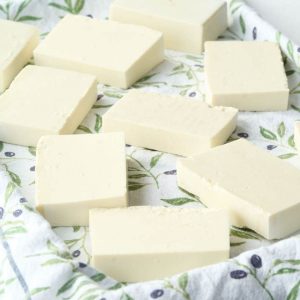
Equipment
- 10-inch soap mold
Ingredients
- 9.5 ounces water
- 3.82 ounces lye
- 30 ounces olive oil
- 2 tablespoons orange essential oil (optional for fragrance)
- 0.6 ounces sodium lactate (optional, creates a firmer bar)
Save This Recipe
You'll join my email list which you will love. And if you don't, unsubscribe in one click. ❤️
Instructions
- Prepare your workspace. Before starting the soap-making process, take all necessary safety precautions. Put on your safety goggles, gloves, and long sleeves. Make sure your workspace is well-ventilated and free from any distractions like pets or children.
- Combine the lye and water. In separate, non-reactive containers, measure out the lye and water. Slowly add the lye to the water (never the other way around), stirring until the lye dissolves completely. Set aside in a safe, well-ventilated place and allow the lye water to cool to 100-115°F (38-46°C). While the lye solution cools, proceed to the next step.
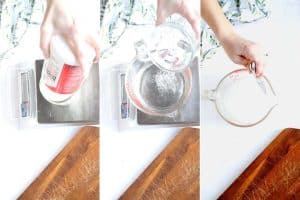
- Warm the olive oil. Add all the olive oil to a large, non-reactive saucepan. Gently heat over medium-low heat until the oil reaches 130-140°F (54-60°C). Once heated, set the oil aside to cool to 100-115°F (38-46°C). This may take an additional hour or so. Tip: If your olive oil cools faster than the lye water, you can gently reheat the oil to bring it back within the desired temperature range. Avoid reheating the lye water.

- Prepare for blending. Before combining the lye solution with the oil, prepare your soap mold and have any optional fragrance (like orange essential oil) and color ready to go. If you use sodium lactate, add it to the cooled lye water just before mixing.
- Combine the lye solution with the oil. Pour the lye water into the pot with the olive oil. Using a stick blender, blend the mixture until "trace" is reached. Trace is when the soap batter thickens, and you can drizzle it on top of itself, leaving a trail that stays on the surface for a moment before sinking back in. This stage may take at least five minutes of blending. The mixture should resemble a thin pudding.

- Pour soap into the mold. Immediately pour the soap batter into the prepared soap mold. Smooth the top with a spatula if needed. Allow the soap to cure in the mold for 24-48 hours at room temperature.

- Unmold and cut into bars: Carefully turn the soap out of the mold. Cut the soap into bars using a sharp knife. Place the bars on breathable fabric or wire racks in a cool, dry, well-ventilated space to cure for at least four weeks. Curing allows the soap to harden and any remaining moisture to evaporate, resulting in a longer-lasting bar. Turn the bars occasionally to ensure even curing.

Video
Notes
Did You Make This?
I would love it if you would leave a review!More Tips:
Making soap is a bit like baking – precise measurements are really important. Use a digital scale to measure your ingredients, especially the lye and water, down to the exact ounce. Even small differences can alter the texture and quality of your soap.
Before combining the lye solution and olive oil, make sure their temperatures are within the recommended range. If one cools faster than the other, use a thermometer to check and gently reheat as necessary. This ensures the soap batter comes together smoothly and prevents any unwanted separation.
When using the stick blender, blend in short bursts instead of continuously holding it. This helps prevent over-blending, which can thicken the soap batter too quickly. Stop blending and stir by hand periodically to check if a trace has been reached.
It might be tempting to use your soap right away, but curing is important. Allowing your soap to cure for at least four weeks helps it to harden fully and ensures a better lather. Place the bars in a well-ventilated area, and if possible, turn them over every few days to help them cure evenly.

Key Ingredients and Tools
When making this soap, here are key tools and ingredients that play a crucial role in the process:

- Lye: Lye is vital for transforming oils into soap through a process known as saponification. It can be found at most hardware stores or online, but handle it carefully as it is a potent chemical.
- Digital Scale: Accurate measurements are essential in soap making. A digital scale ensures you get the precise amounts of ingredients required, which is key to achieving consistent results every time.
- Sodium Lactate: This optional ingredient helps your soap harden faster and facilitates easier unmolding, especially in humid conditions. If unavailable, you can use salt (about 1 teaspoon per pound of oils) to help harden the soap, though the outcomes may vary.
- Stick Blender: This tool expedites the process of reaching “trace,” the stage when the soap mixture thickens. It is much faster and more effective than stirring by hand.
- Olive Oil: Olive oil is the star ingredient in this recipe, known for creating a mild, moisturizing soap with a creamy lather. If a substitute is needed, any other liquid oil like sunflower or almond oil can be used, but remember that this will alter the texture and lather of the soap.
- Orange Essential Oil: This adds a lovely citrus fragrance to your soap, making it smell fresh and invigorating. If you prefer a different scent, you can replace it with any essential oil you choose, such as lavender or peppermint. Just be mindful of the oil’s strength and potential skin sensitivity, especially if using stronger oils like cinnamon or clove.
By taking into account these items and considerations, you can create the best possible soap at home, ensuring it turns out smooth, firm, and beautifully finished.
Making your own Olive Oil Castile Soap can be a fun and rewarding experience. It’s a great way to create a gentle, moisturizing bar that’s perfect for everyday use.
Whether you’re new to soap-making or have some experience, this recipe is a straightforward way to enjoy the benefits of natural, handmade soap. Take your time, follow the steps, and relish the satisfaction of crafting something truly beneficial for your skin and home.

Love,


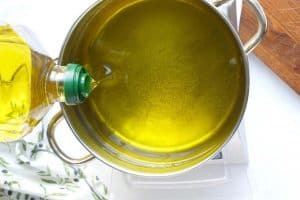

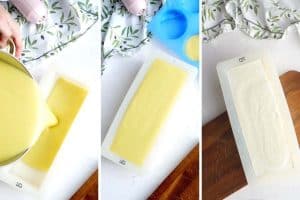
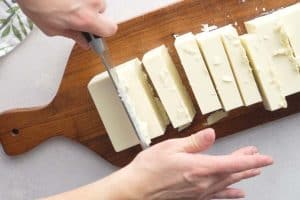









Thanks for the good info but seriously, only obsolete imperial measures instead of metric ?
Every nation had its own version of the various apothecary measures eg,
US pint = 473 ml, UK pint = 568 ml
US gallon = 3.78 litre, UK gallon = 4.54 litre but, 1 litre is 1 litre no matter who or where you are in the world. And that is just the difference between the US and UK, now add all the other European countries etc. that had their own versions of cups, pints, miles, fathoms, gallons etc. That is why over 98% of the world now uses metric. Even the von Braun team that founded NASA used metric. How many computers or OS systems are based on imperial ? ZERO, not one, decimal only. The smallest measure in the world is also metric. Get with the times America, it’s been over 50 years past imperial measures now.
i’m sorry that you wasted so much time on this rant and that it will change no one’s opinion. we use the measurements we grow up and i can’t personally do much about that.
Love that recipe! Thank you from from Greece
I love the simplicity of this recipe. Thank you for sharing it. I have been infusing different herbs into olive oil so I’m so very excited to experiment with them.